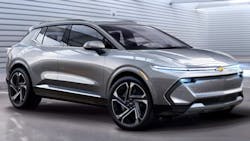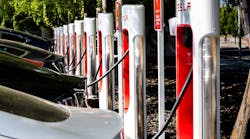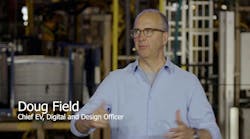GM CFO Previews the Looming End of ‘Irrational Behavior’ in the EV Market
Electric vehicles’ share of the total automotive sales market climbed to more than 9% this month, analysts at Cox Automotive said Aug. 15. Total sales, the firm said, climbed almost 20% year over year to a little more than 130,000, the second-highest figure on record.
Similarly, dealer software and data company StoneEagle said leases of EVs jumped in July from the month before, accounting for nearly 20% of all leases. Several companies have been putting up some eye-popping growth rates: General Motors Corp. booked more than 19,000 sales during the month, an increase of 115% from last year’s July, while Audi (+150%) and Volkswagen (+454%) soared higher still.
Alas, those are almost certainly sugar-high numbers.
After several topsy-turvy years marked by the demise of some nascent EV brands—Fisker and Lordstown Motors perhaps most prominent among them—and by established names pulling back on investments and pushing out development timelines, the EV market is preparing for big regulatory changes courtesy of the One Big Beautiful Bill Act. That legislation will end federal tax credits of $7,500 for new EVs and $4,500 for used EVs on Sept. 30.
The looming end of those credits—introduced as part of the Inflation Reduction Act, they were originally set to expire at the end of 2032—has created a rush to buy among consumers and a big dose of uncertainty about what comes after for manufacturers. Paul Jacobson, CFO of General Motors Corp., said at the recent J.P. Morgan 2025 Auto Conference that the economics of building and selling EVs are set to change rather drastically—and that’s before other potential changes might take effect.
Jacobson discussed those dynamics as part of a broader conversation with analyst Ryan Brinkman. Here, lightly edited for clarity and brevity, is the portion of their chat that focused on the latest evolution of emissions regulations and the EV market—and how they’re likely to boost GM’s bottom line.
Brinkman: I wanted to ask about the implications for GM profit from the shifting regulatory framework with regard to EVs, in particular—such as the early expiration of the $7,500 federal consumer tax credit as well as the removal of the penalties for noncompliance on greenhouse gases and corporate average fuel economy.
It seems like some things are helping you, some things are hurting you. There are quite a few moving pieces with tailwinds from needing to pay fewer fines and credits, potentially a richer mix of vehicles sold—maybe more vehicles sold. But then the headwinds, also, from less pricing support. I wonder, too, [about] less maybe irrational pricing activity on the part of some people selling vehicles under cost so they can just get a credit. So, a lot of moving pieces.
There was even a discussion on the last earnings call of yet another layer of nuance. I think you said the math gets complicated very quickly, right? [It was] relating to needing to maybe write off some of the credits already purchased. So can you just help us dimension all of these headwinds and tailwinds or maybe just wrap it all up and say what the net impact for GM might be?
Jacobson: Suffice it to say, it gets really complicated really fast. But just trying to sort through that: What we already know today is that the administration has handled CAFE. So CAFE penalties were zeroed out; any credits that we had will have to be written off […] but any forward liabilities that we’d already accrued also get written down. We think that those two things are essentially a wash and it will be somewhat immaterial on 2025 going forward. It will save us money in 2026 and beyond for sure. We haven’t disclosed exactly what that is because we’re waiting to really do it all kind of at once.
People [were] trying to drive volume because they weren’t interested in selling EVs as much as they were interested in creating credits that they were otherwise going to potentially be short going forward.
[Greenhouse gas emissions policy] is not resolved yet. There are commitments from the administration to do that, but it’s important that we let them run their process and get done what they need to do. But suffice it to say, we do think that this is net accretive for the enterprise for the long haul. And a lot of it has to do with where EVs are.
So first of all, if GHG penalties are eliminated—and that’s just for discussion purposes; I don’t know that that’s where it’s going to go—then that means that electric vehicles are going to be less profitable than they are today because everybody, including us, takes the value of the credits that are created, which is a couple of thousand dollars plus per vehicle. So the burden to get to EV profitability goes up but it’s a net positive for the enterprise.
And that net positive for the enterprise versus the status quo is quite a bit better when you think about where we were trying to go for 2030. Because what was really creating the irrational behavior was the steepness of the stringency curves going up to a mandated 50% adoption by 2030 in a market that’s sitting at about 7% to 8% right now. That was leading to a lot of heavy discounting behavior, people trying to drive volume because they weren’t interested in selling EVs as much as they were interested in creating credits that they were otherwise going to potentially be short going forward.
We think a lot of that is probably going to go by the [wayside]. In fact, I would be surprised if there aren’t fewer EV retailers or EV sellers in the next four to five years—assuming GHG is relaxed—than there are today because many people were selling EVs just so they could continue to sell their ICE franchise that they’ve done quite well with.
So I think the market becomes more rational from that standpoint. The enterprise gets net better immediately from that standpoint. When you look at what EVs are to us, we think that there is still continued opportunity for us to significantly reduce our losses and ultimately drive that portfolio to profitability. It might take a little bit longer in the face of lower demand.
But [then] you look at the structural changes that we’ve announced with [lithium-manganese-rich] battery technology, going to prismatic [battery] cans, the new agreement with LG Energy Solution as well as with Samsung SDI. We think there’s a lot of room for improvement in our structural costs while we continue to put product out there that is actually accreting quite a bit faster than the rest of the market.
So we know we’ve got a winning portfolio. But structurally, we’ve got to get to where the costs are lower overall. But in the meantime, it’s net, like I said, immediately better for the enterprise if GHG gets resolved.
About the Author
Geert De Lombaerde
Senior Editor
A native of Belgium, Geert De Lombaerde has been in business journalism since the mid-1990s and writes about public companies, markets and economic trends for Endeavor Business Media publications, focusing on IndustryWeek, FleetOwner, Oil & Gas Journal, T&D World and Healthcare Innovation. He also curates the twice-monthly Market Moves Strategy newsletter that showcases Endeavor stories on strategy, leadership and investment and contributes to other Market Moves newsletters.
With a degree in journalism from the University of Missouri, he began his reporting career at the Business Courier in Cincinnati in 1997, initially covering retail and the courts before shifting to banking, insurance and investing. He later was managing editor and editor of the Nashville Business Journal before being named editor of the Nashville Post in early 2008. He led a team that helped grow the Post's online traffic more than fivefold before joining Endeavor in September 2021.



